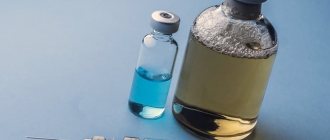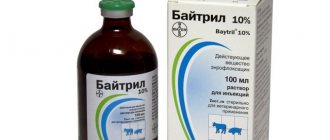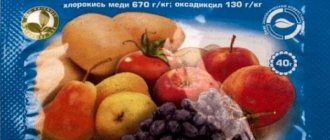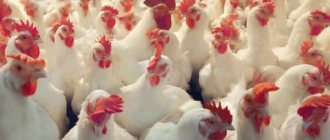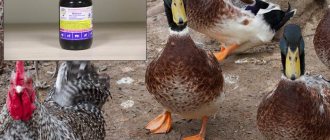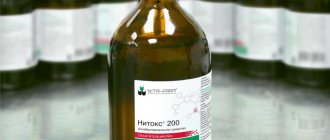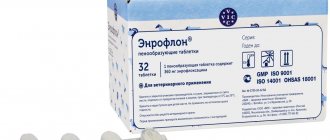Poultry farmers know that young animals are susceptible to infection by bacteria and other pathogens. A fragile body cannot fully fight the disease, which often leads to massive mortality and losses. To preserve livestock, poultry farmers resort to antimicrobial drugs that effectively destroy pathogenic bacteria without having a negative effect on the growing organism.
These products include Baytril for birds, a broad-spectrum antibiotic that can relieve birds from many health problems. Before using the medicine, you should be sure to familiarize yourself with the method of use, dosage and recommendations, since careless use of Baytril can provoke the development of dysbacteriosis in birds.
Description of the drug Baytril
A product with a wide spectrum of action that can be used both for treatment and for prophylactic purposes to prevent bacterial infections. The active ingredient in the medicine is called enrofloxacin, it belongs to the group of fluoroquinolones, which are similar in action to antibiotics.
Depending on the concentration of the active ingredient in the composition, the drug Baytril is produced in several forms:
- 5% solution for injection;
- 10% solution for oral administration;
- 10% solution for mixing with feed.
For poultry, Baytril 10% is usually used - a transparent yellowish solution, available in bottles with different volumes.
In what cases is the use of an antibiotic indicated?
The active ingredient of Baytril is enrofloxacin.
The drug is available in the form of a yellow solution, packaged in ampoules, plastic or glass bottles. To treat birds, Baytril 10% is used directly, a solution containing 100 mg of enrofloxacin in 1 ml. There are also dosages with 2.5 and 5% concentration. The drug is used to treat all poultry. It is indicated for diseases of the respiratory system and gastrointestinal tract, namely:
- mycoplasmosis;
- streptococcosis;
- necrotic enteritis;
- salmonellosis;
- colibacillosis;
- hemophilia.
The antibiotic quickly penetrates the body by absorption through the stomach. It retains its effect for another day and is eliminated almost completely.
Pharmacological properties
The active ingredient in Baytril, enrofloxacin, fights various types of bacteria. The substance instantly destroys some pathogenic microorganisms and prevents the proliferation of others, which stops the development of the disease. After taking Baytril, the symptoms caused by the infection disappear, the bird feels much better and recovers.
The drug has a detrimental effect on pathogenic bacteria, while being safe for the health of adult birds and young birds, and does not have a negative effect on the reproductive system. The drug is excreted from the body along with feces.
Despite its high effectiveness, for advanced infections, the use of Baytril does not guarantee recovery. When using the drug for preventive purposes, you should be especially careful and careful, since incorrect dosages and too long use can provoke the development of dysbiosis.
Composition and pharmacological action
The veterinary drug has an antibacterial effect due to enrofloxacin. The substance is a derivative of quinolocarboxylic acid. Many pathogenic microorganisms of bacterial origin, as well as mycoplasma, are sensitive to it.
Have you used Baytril on chickens before?
Yes
0%
No
0%
Once inside the body, enrofloxacin is quickly absorbed into the blood, penetrating all tissues of the body. The antibacterial effect develops within half an hour after administration and persists for 24 hours.
The antibiotic stops the growth and division of pathogenic microorganisms, causing morphological changes inside the cell. This in turn leads to the rapid death of bacteria and mycoplasmas.
It is excreted mainly unchanged and partially with urine and eggs in laying hens in the form of a metabolite, ciprofloxacin.
In addition to the active substance, the solution contains injection water, n-butanol and potassium oxide hydrate.
Baytril dosage
The drug Baytril can be used for treatment and prevention in the following species of birds:
- chickens;
- geese;
- ducks;
- turkeys;
- quail;
- pigeons;
- parrots
According to the instructions for use, the medicine Baytril 10% for birds is used for oral administration: the product is mixed with drinking water at the rate of 0.5 ml/1 l . Before giving the medicinal solution to chickens and other birds, the drinking bowls should be thoroughly washed and disinfected.
Traditional methods of prevention
It is not necessary to carry out prevention for pigeons only with tablets and injections. Folk remedies have proven themselves well; they are often used in poultry farming. Most often, this is propolis directly from the honeycomb, or rather, a tincture based on it, which is similar in action to the drug Baytril. To prepare it you should use the following recipe:
Ingredients:
- Propolis - 60 g or ml;
- Alcohol - 0.5 l.
You need to mix both components and leave in a cool, dark place for 2-4 days. As soon as the formation of sediment becomes noticeable, this will mean that the tincture is ready and can be given to pigeons. However, first you must strain it through a sieve to get rid of the waxy sediment. The tincture is added to the drink, judging by the reviews, pigeons drink it with pleasure. Also, in order to improve the health of pigeons, you can use apple cider vinegar, tansy, an aqueous solution of iodinol, copper sulfate, and so on.
Instructions for use of Baytril for birds
Baytril 10% is recommended for the treatment and prevention of dangerous diseases in birds.
The drug stops the vital activity and reproduction of pathogenic microorganisms, allowing you to save birds from certain death.
If the rules of use and storage are followed, the medication is well tolerated by birds without causing side effects. Before use, you should read the instructions.
For poultry
For the prevention and treatment of diseases in poultry (ducks, geese, turkeys and other livestock), Baytril 10% is used for oral administration. To use the medicine, for example, for chickens, you need to dilute 5 ml of the medicine in 10 liters of drinking water and pour it into drinking bowls. In order to save medicine, you should calculate in advance what the daily water consumption of birds is.
The duration of treatment for severe infectious diseases is from 5 days, for mild ones - from three days. In rare cases, the course of treatment may be extended by the veterinarian after examining the birds. It is necessary to prepare a fresh solution daily to avoid the development of side effects and complications.
For quails
For small quails, the use of Baytril is recommended in hot weather, when the birds' bodies are weakened and exposed to bacterial attacks. To prevent and treat diseases, quails are given 1 ml of Baytril 10% per liter of drinking water. The course of administration depends on the condition of the bird and the type of infection, but should last no less than 5 and no more than 12 days. During this period, ordinary water cannot be given, only a medicinal solution.
For pigeons
Baytril dosage for pigeons is 1 ml/1 liter of water. Sometimes birds may refuse to drink the offered solution. In this case, the farmer will have to solder each individual separately, using a syringe without a needle or a pipette. Baytril for pigeon chicks is used as follows:
- At the age of 10–20 days, the dose is 1/20 of a 1 ml ampoule.
- For chicks 21–40 days old - 1/10.
- At the age of 41–70 days - 1/5 part.
The course of treatment lasts 3–5 days depending on the condition of the birds and the purpose of use. Before using the medication, it is recommended not to feed the pigeons for a day.
For parrots
Baytril 10% for oral administration is also used to eliminate symptoms and improve the condition of parrots. The product is diluted in water at the rate of 1 ml/0.2 l and given to parrots for 5 days.
Purpose
Baytril is used to treat diseases of poultry, rabbits, pigs, calves, cats and dogs. This article will discuss the use of antimicrobial agents for poultry. Baytril 10 is used mainly. Although, with a small number of individuals or their small mass, the medicine can be given in other concentrations.
Baytril is indicated for use in the following bacterial infections of poultry:
- Paratyphoid fever, white bacterial diarrhea.
- Mycoplasmosis.
- Colibacillosis.
- Hemophilosis.
- Mixed infections.
Baytril is in demand when carrying out preventive feeding of chicks of chickens, geese, ducks, and turkeys with antimicrobial drugs. To prevent the use of Baytril from leading to dysbacteriosis, chickens must be given the medicine for three days.
In case of severe disease, under the supervision of a doctor, treatment can be extended to 5 days. In this case, you will need to restore digestion with the help of probiotics. In most situations, if symptoms of damage to the respiratory organs, intestines or eyes are detected, antibiotic therapy must be started before an accurate diagnosis is made, otherwise the entire livestock may be lost.
Should Baytril be given to broilers?
Baytril for chickens, especially broilers, is an indispensable tool that helps prevent many dangerous diseases. According to the instructions for using Baytril for chickens, the medicine is given as follows:
- On the 8th day after hatching, a solution is prepared for the chicks at the rate of 1 ml/2 l of water. Young chickens are pre-fed with vitamins.
- The prepared Baytril solution for broilers is fed to the chicks for two days.
- On the 9th day, vitamin complexes are introduced into the chickens’ diet.
- The dose is repeated on the 28th day of life.
When using medication for broiler breeds, you should be careful and first consult with a veterinarian, as abuse of the drug can weaken the bird’s immunity.
Indications for use
The drug is used to treat infections caused by the following types of bacteria:
- Mycoplasmas (cause mycoplasmosis);
- Salmonella (causes salmonellosis);
- Eschijeria;
- Clostridia (causes diarrhea);
- Haemophilus influenzae;
- Shigella;
- Bacteroides.
These bacteria also cause respiratory diseases (rhinitis, bronchitis). In such cases, chickens develop mucous discharge from the beak and wheezing. Bacteria cause conjunctivitis and various diseases of the digestive system - enteritis.
Baytril helps in the treatment of these diseases, but we must remember that in severe cases, the drug is powerless. Therefore, treatment begins immediately after symptoms appear.
Contraindications
The medicine Baytril is not used for the prevention and treatment of laying hens, since the active substance accumulates in the eggs, making them unsuitable for consumption. In addition, it is prohibited to use the drug in combination with the following medications:
- Levomycetin, Tetracycline, Theophylline;
- agents from the group of macrolides;
- non-steroidal anti-inflammatory drugs.
The medicine is not used during the period of livestock vaccination.
You can eat poultry meat treated with Baytril only 11 days after the last dose of the drug.
Group of generic drugs
There is a special group of medications that are commonly called universal. They are used to prevent or stop the disease at the initial stage of its development. These are drugs for pigeons such as levamisole, parastop, farmazin, enroxil, enrofloxacin, vladivak, sporovid or enroflon in the form of an aqueous solution.
Timely use of the above medications to prevent diseases in pigeons will keep their health under control and allow them to die from one or another disease. It is important to start a preventive course immediately after the first symptoms of illness are noticed, when the bird becomes restless, eats poorly or, conversely, prefers not to get up, stops flying, and so on.
Storage conditions
Manufacturers recommend storing Baytril in a dark, dry place away from bright sunlight, away from children and pets.
Subject to storage conditions, the drug remains effective for three years from the date of release. The medicine in open packaging can be used for a month, after which the product must be disposed of. Baytril is a broad-spectrum drug that regularly helps save thousands of birds around the world. High efficiency, convenient use, accessibility and safety are only part of the advantages of Baytril, which is why the medicine is popular among poultry farmers and is always kept in first aid kits.
Specifics of use of funds
An antibiotic is a synthetic or natural substance that suppresses the vital activity of various living cells, mostly protozoa and prokaryotes. Such substances have little effect on viruses, but do an excellent job of destroying bacteria. Antibiotics have virtually no effect on the cells of the macroorganism, that is, the carrier of bacterial microflora.
Due to its physiology, chicken does not tolerate infection by viruses and bacteria. If one individual gets sick, the entire flock will be infected. And death, without taking appropriate measures, is inevitable. Antibiotics such as baytril, levomycin, etc. will help chickens survive the disease.
The same drugs are often used for animals, birds and people. However, the concentration of the active substance varies, since a number of factors must be taken into account:
- the weight of the animal or bird - it is obvious that to treat a chicken, the dose of medicine should be significantly less;
- origin - a drug of this kind must, on the one hand, have the ability to accumulate in order to prolong its effect, and on the other hand, be completely eliminated from the body. Of course, the mechanism of interaction between the chicken body and antibiotics is different from the processes occurring in the human body;
- the condition of the bird - to prevent the disease and to treat it, drugs of varying degrees of effectiveness and in different doses are used.
conclusions
- Baytril is an antibiotic that effectively fights many bacteria.
- The active substance of the drug is enrofloxacin.
- Baytril is contraindicated for laying hens.
- To treat birds, purchase Baytril with a concentration of 10%.
- This drug can treat salmonellosis, a dangerous common disease among chickens.
- The medicine is diluted in water and soldered with a solution of birds. The treatment period for a mild form of the disease is 3 days, for a severe form of the disease – 5.
- Be sure to consult your veterinarian before starting treatment.
- After treatment, vitamin complexes must be included in the livestock diet.
- The drug has several analogues, which differ in the excipients in their composition and price.
- "Baytril" for broiler chickens is an indispensable drug in the treatment of many dangerous infectious diseases.
How to raise broiler chickens without loss
Often, infections and diseases affect a fragile body due to improper care. Therefore, it is important to know the most dangerous symptoms of diseases and rules for caring for livestock. So the chicken should be transferred to a brooder with a temperature of 30 C and with an influx of fresh air, since if there is a lack of oxygen, the chicken will inevitably get sick. The temperature in the brooder and lighting are maintained in accordance with the development schedule of the squeakers.
It is important to remember that in the first day the chicken is sterile not only outside, but also inside. It does not have enough enzymes and bacteria to digest food. Therefore, food and drink are provided without excess, so as not to rot in a weak gastrointestinal tract.
If you maintain the regime and fortify the feed, the chickens grow quickly, increasing their weight 50 times per month. For 1 kg of weight you will need to spend 2 kg of feed. For rapid development and health, prevention is carried out. But at the slightest suspicion of illness, the chick is isolated, and the struggle for survival begins.
Natural vitamins
In order for chickens to grow strong and healthy, it is necessary to use natural vitamins found in vegetables and herbs. They partially replace vitamins from the pharmacy.
In spring, it is recommended to let birds out more often for walks on green grass. It is very useful, and broilers peck at it with pleasure.
The following products are added to the chicken mash:
- green onions kill intestinal parasites and contain sulfur. It is recommended to feed it to young animals from the fifth day of life;
- Chickens get calcium from low-fat dairy products, which are added to the feed;
- sorrel contains trace elements and protein;
- cabbage contains sulfur and vitamin K. It is added to food in small quantities;
- chopped vegetables, nettles, steamed hay, dandelion leaves;
- yeast is needed for intestinal microflora. Give a little in the feed from the eighth day.
To raise healthy broilers and get tasty and healthy meat, you need to properly care for the bird from the first days of life. It is important that chickens receive adequate nutrition, and sick birds receive timely treatment. Medicines and vitamin supplements will help with this.
